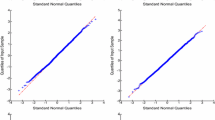Abstract
Semiparametric transformation models provide a class of flexible models for regression analysis of failure time data. Several authors have discussed them under different situations when covariates are timeindependent (Chen et al., 2002; Cheng et al., 1995; Fine et al., 1998). In this paper, we consider fitting these models to right-censored data when covariates are time-dependent longitudinal variables and, furthermore, may suffer measurement errors. For estimation, we investigate the maximum likelihood approach, and an EM algorithm is developed. Simulation results show that the proposed method is appropriate for practical application, and an illustrative example is provided.
Similar content being viewed by others
References
Cai, T., Cheng, S.C., Wei, L.J. Semiparametric mixed-effects models for clustered failure time data. J. Am. Statist. Assoc., 97: 514–522 (2002)
Carey, J.R., Liedo, P., Müller, H.G., Wang, J.L., Chiou, J.M. Relationship of age patterns of fecundity to mortality, longevity, and lifetime reproduction in a large cohort of Mediterranean fruit fly females. J. Gerontol.: Biol. Sci., 53: 245–51 (1998)
Chen, K., Jin, Z., Ying, Z.L. Semiparametric analysis of transformation model with censored data. Biometrika, 82: 659–68 (2002)
Chen, K., Tong, X. Varying coefficient transformation models with censored data. Biometrika, 90: 1–8 (2010)
Cheng, S.C., Wei, L.J., Ying, Z. Analysis of transformation model with censored data. Biometrika, 89(3): 835–45 (1995)
Efron, B. Missing data, imputation and bootstrap (with Discussion). J. Am. Statist. Assoc., 89: 463–79 (1994)
Fine, J.P., Ying, Z., Wei, L.J. On the linear transformation model for censored data. Biometrika, 85: 980–86 (1998)
Henderson, R., Diggle, P., Dobson, A. Joint modeling of longitudinal measurements and event time data. Biostatistics, 4: 465–80 (2000)
Jin, Z., Lin, D.Y., Wei, L.J., Ying, Z. Rank-based inference for the accelerated failure time model. Biometrika, 90: 341–353 (2003)
Kalbfleisch, J.D., Prentice, R.L. Statistical analysis of failure time data, Second Edition. John Wiley, New York, 2002
Kong, L., Cai, J., Shen, P.K. Weighted estimating equations for semiparametric transformation models with censored data from a case-cohort design. Biometrika, 91: 305–319 (2004)
Lin, D.Y., Ying, Z. Semiparametric analysis of the additive risk model. Biometrika, 81: 61–71 (1994)
Louis, T.A. Finding the observed information matrix when using the EM algorithm. Journal of Royal Statistics Society Series B, 44: 226–233 (1982)
Lu, W., Tsiatis, A.A. Semiparametric transformation models for the case-cohort study. Biometrika, 93: 207–214 (2006)
Mclachlan, G.J., Krishnan, T. The EM Algorithm and Extensions. Wiley, New York, 1997
Tseng, Y.K., Hsien, F., Wang, J.L. Joint modelling of accelerated failure time and longitudinal data. Biometrika, 92(3): 587–603 (2005)
Tsiatis, A.A., DeGruttola, V., Wulfsohn, M.S. Modeling the relationship of survival to longitudinal data measured with error. Application to survival and CD4 counts in patients with AIDs. J. Am. Statist. Assoc., 90: 27–37 (1995)
Wang, Y., Taylor, M.G. Jointly modeling longitudinal and event time data with application to acquired immunodeficiency syndrome. J. Am. Statist. Assoc., 96: 895–905 (2001)
Wulfsohn, M.S., Tsiatis, A.A. A Joint Model for Survival and Longitudinal Data Measured with Error. Biometrics, 33: 330–339 (1997)
Zeng, D., Lin, D.Y. Efficient estimation of semiparametric transformation models for counting processes. Biometrika, 93: 627–640 (2006)
Zhang, Z., Sun, L., Sun, J. Regression analysis of interval-censored failure time data with linear transformation models. The Canadian Journal of Statistics, 33: 61–70 (2005)
Author information
Authors and Affiliations
Corresponding author
Rights and permissions
About this article
Cite this article
Cheng, Xm., Gong, Q. Joint modeling of failure time data with transformation model and longitudinal data when covariates are measured with errors. Acta Math. Appl. Sin. Engl. Ser. 28, 663–672 (2012). https://doi.org/10.1007/s10255-012-0192-0
Received:
Published:
Issue Date:
DOI: https://doi.org/10.1007/s10255-012-0192-0




